
24 minute read
Loop Wide Elements
The Emerald Loop is a conceptual necklace connecting Greenville’s existing and envisioned cultural gems. The "Loop" includes an inner necklace, which defines a more pedestrian circuit; and an outer necklace, which defines a more vehicular circuit. Radiating out and connecting these loops are strands noting important streets. The Loops also delineate a geographic area within which a civicscale lighting project is proposed.
Loop Defining Necklaces
Advertisement
The essential framework of the Emerald Loop includes art projects that define a connective loop, or series of loops, that can be experienced episodically on foot or by bike, car or trolley. The major loop defining artworks include: • Gateways, a series of artworks integrated into key intersections along or adjacent to the inner and outer Emerald loops. • Emerald Loop Trolley, a unique mode of transit including trolley car and trolley stop art elements • Treasure Hunt, a series of small artworks or
“hidden gems” along the loop to be discovered by art-treasure hunters of all ages
Emerald Lighting
District-wide Lighting, a lighting plan to be applied to architectural towers and facades throughout Greenville's Center City (only Gateway lighting locations are shown on adjacent map)
Loop Defining Necklaces
Emerald Loop Trolley
Cultural Connector
The City of Greenville has recently received three historic trolley cars from the City of Raleigh. Given the popularity of Greenville’s Jolly Trolley, which can be hired for private events, it is proposed that one or more of the City’s new trolleys be converted into a regularly-scheduled “art trolley” that would both define the Emerald Loop and provide connection between various cultural gems, promoting visitation to and connection between venues.
Like all forms of public transportation, the trolley will be an equalizer; anyone is invited to ride it. With the application of art, the concept is to entice people of all backgrounds – families, students, faculty, professionals, artists and all – to hop on for a communal art experience in addition to the utility of getting from place to place.
The Emerald Loop Trolley will be not only a means of transportation connecting points in Greenville's Center City, but a destination in and of itself.
Trolley Car
With the application of art to both the exterior and the interior of the trolley car, people might get on just for the ride, enjoying an art ambiance and striking up conversations with others also riding. Lighting will play an important role in marking the trolley. LEDs will be incorporated into both the exterior and the interior of the car, creating a striking and theatrical presence on the road. The lights will be color-changing to enable a variety of appearances for different holidays and events, but to emphasize the “emerald” concept, the lights will be predominately in shades of green in sync with the color palette proposed for the citywide "Emerald Lighting" initiative. In addition, architectural surfaces and details of the interior and exterior will be painted or vinyl wraps applied. Seating treatments may be added. The Emerald Loop Trolley cars can incorporate music and tour guide "sound loops," with pre-recorded sound tracks played on the vehicle speakers as well as live performances. At least one of the City's three trolley cars must be reserved for use when the regularly-running cars are being maintained.
Trolley Route
The Trolley route will be determined by City transportation planners working with cultural planners. A shorter "Inner Emerald Loop," connecting cultural destinations in the Center City, will intersect with a longer "Outer Trolley Loop," connecting people from Vidant and the Convention Center to Greenville's urban core.
Many of the Center City’s streets are one-way, which suggests a one-way inner loop (counterclockwise in the current design). Preliminary stop locations, routes and schedules should be betatested and refined based on ridership patterns and user experiences and durations both waiting for and riding the Trolley.
Trolley Stops
The Trolley stops should be as interesting as the Trolley car itself, incorporating an interactive art experience. Elements of the stops are anticipated to include a light pole (tying aesthetically to light poles used at Emerald Loop Gateways), small seats, canopy, paving demarcation, photovoltaic cells to generate “green” energy, and small interactive features. The stops are envisioned as iconic and unique features that also identify the Emerald Loop.
To begin, Trolley stops may be marked with a simple graphic sign mounted on an illuminated pole. Later, placemaking elements can be introduced. An RFP for artist designed stops can be used; or a cohesive "kit of parts" can be designed – including a paving marker, seat, canopy and interactive element – and placed as appropriate at various stops. Depending on site conditions, some stops may have multiple seats, while others have just a small canopy attached to the light pole. Trolley stop elements can be implemented by the City, University or private property owners.
ELEMENTS Trolley Car: • Paint • Reflective film • Window decals • Undercarriage lights • LED lighting • Ceiling mural • Hub caps Trolley Stop Elements: • Graphic reflective sign • Illuminated pole • Green solar panel • Paving treatment • Seat • Canopy • Interactive piece
Existing Trolley exterior

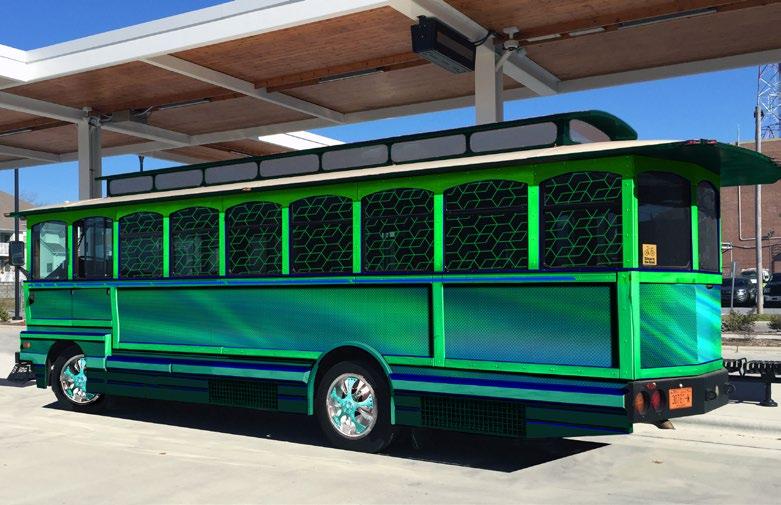
Proposed Emerald Loop Trolley exterior with reflective film, painted trim, hexagonal window decals and hubcaps
Existing Trolley interior

THEMES & EXPERIENCES
• Collective experience • Chance meetings • The color green • Emerald gem structure • Photo op + interactive elements
SITE INTEGRATION • Center City route connects cultural destinations • Outer City route connects Vidant and/or Convention
Center to Center City • Integrate Emerald Loop Trolley routes with bus routes, bike lanes and greenways • Initially run Trolley on weekends and special events • Expand schedule as ridership increases • Collaborate with City and individual property owners to fund and select locations for trolley stops • Priority Emerald Loop project
Proposed Emerald Loop Trolley's illuminated ceiling mural, featuring a hexagonal grid; with busker
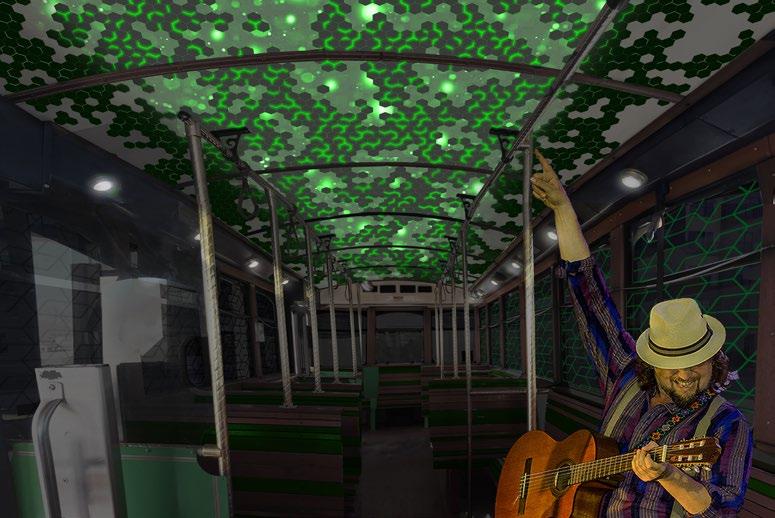
Emerald Loop Trolley stop marker concepts, with reflective stainless steel and green retro-reflective film surfaces, and hexagonal cut-outs with internal "lantern" lighting
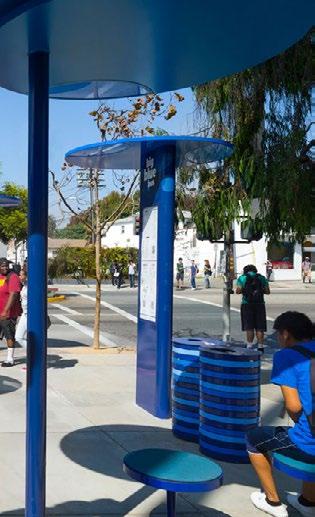
“Big Blue Bus” stops in Santa Monica, CA; with solar-powered canopies, small seats and cohesive color to identify the line
Treasure Hunt
Treasure Hunt Experience
Playing off the pirate iconography of ECU, Pitt County’s Visitor Bureau is introducing the motto, “find the hidden gems.” The Emerald Loop can tie into this agenda by creating a hunt for cultural treasures in Greenville's urban core. This treasure hunt can consist of a series of small artworks incorporated into the streetscape, plazas, landscape and buildings along the Emerald Loop. The treasures will form an art walk experience in which the primary ostensible goal is to discover these small artworks, with ancillary goals of enticing people to walk between neighborhoods and visit establishments and places they encounter in the process of searching for the treasure. Other cities, agencies and artists have implemented similar concepts, both temporary and permanent, such as gnome hunts and pothole mosaics, which activate and draw people into the public realm.
Cultural Treasures
Greenville’s history is abounding with fascinating stories and inspiring characters. Individual artworks may be inspired by unique events or persons of interest linked to Greenville. The form of the artworks could include miniature bronze-cast sculptures, small glass mosaics, micro-murals or interactive game-like elements.
Thematically relevant "treasures" can be installed in conjunction with implementation of the African American Cultural Trail.
Implementing the Treasure Hunt
The Treasure Hunt could be phased in over time, as funds become available. It is recommended that “treasures” be added in groups of at least three pieces at a time, to generate interest and buzz. Alternatively, many treasures could be implemented at the same time if a class at ECU were to take this on as a studio art project. The scale of the pieces makes it particularly well suited for a semester long sculpture or public art studio, in which the first portion of the class would be group work to identify sites and themes and the second half would be the creation and installation of individual pieces by individual students. With this approach, the treasure hunt might even incorporate a game of some kind. THEMES • Find the hidden gems • African American cultural heroes • Storytelling through experiential movement • Connectivity • Emerald Loop ELEMENTS • Small sculptures in durable materials • Micro-mosaics • Micro-murals • Interactive game EXPERIENCES • Where’s Waldo • Getting from one place to another • Hide and Seek • Geocache

Aretha Pothole Mosaic by Jim Bachor
SITE INTEGRATION • Collaborate with City and individual property owners to select locations for artworks • Commission individual artists to install small groups of treasures annually; OR work with an ECU art class to implement all at once

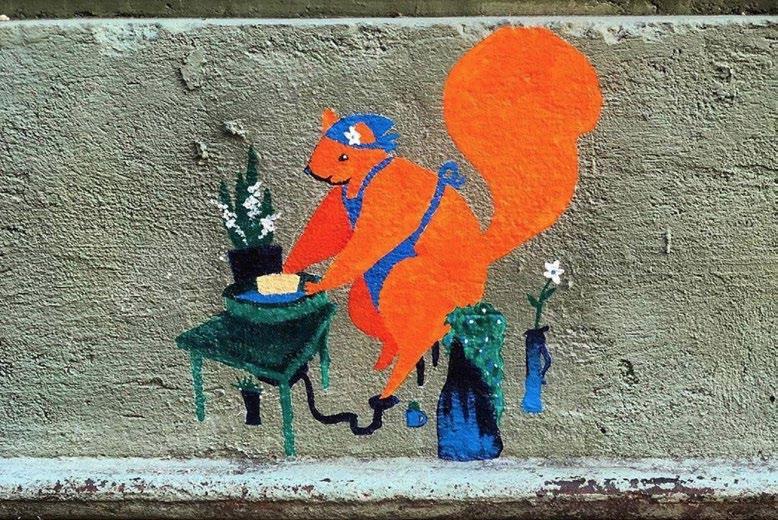

Life Underground by Tom Otternass; figures integrated into New York’s 14th Street – Eighth Avenue station
Ice Cream Sandwich Pothole Mosaic by Jim Bachor



Short Cut by Dan Webb; seven figures found along an exterior staircase in Seattle’s Pike Place Market
Geocache containers or other interactive features may be integrated with treasures Secret Squirrel Micro-Mural Trail, a project being implemented in Greenville by Emerge and Greenville Mural Project Tiny Doors is an Atlanta-based art project; the 7-inch doors are sculptures created by artist Karen Anderson Singer and located in neighborhoods throughout the city
GATEWAYS
GO9 GO1
GO2
GO6
G10
G14
G17
G18 GO3
GO5 GO4
G11

G12
G15 G16 GO7
G13
G19 GO8
Mark Arrivals and Exits
Art Gateways will demarcate key thresholds into the Center City's Arts District. These Gateways will announce the unique qualities and vibrancy of what lies ahead, or behind. Experienced by those in vehicles, on bicycles and on foot, they should be bold and memorable from various vantages and speeds. While they should not be identical, the Gateways should be loosely related to one another in order to express a cohesive identity that reflects the aspirational character of a vital and energized art-centric Center City. An important part of all the Gateways will be the use of light. The Emerald Loop’s inner and outer rings loosely intersect with street intersections at entry and exit points of Greenville's Center City. Strategically placed artwork at these Gateway locations can announce the city center, cultural district and Greenville’s identity; while at the same time calming traffic and signifying a shift from a vehicular to pedestrian environment.
Outer Ring Gateways G01, G03, G04, G08, G09, G17, G18, G19
The Outer Ring Gateways are the first indicators of arrival at the Center City. These all include elements at a large enough scale to be experienced by people in vehicles. Many also include important pedestrian experiences, in particular on the north end of the Loop, where Gateways intersect with passages into Town Common. Artworks proposed for Outer Ring Gateways include permanent iconic bridges and lighting, a sculptural archway, iconic planting and a mural.
Inner Ring Gateways G02, G05, G06, G07, G10, G11, G12, G13, G14, G15, G16
The Inner Ring Gateways signal a transition into the Urban Core. Artworks at these intersections are geared primarily to pedestrians. They include street paving art, light poles, illuminated towers and small sculptures. People in vehicles, of course, will also experience these portals.
Gateways with Paving Art & Light Pole
LOCATIONS
First Priority: G15 Evans Street at Reade Circle • Announce entry into and exit out of Urban Core G10 E. 5th Street at S. Pitt Street • Announce entry into and exit out of Urban Core G13 E. 5th Street at Culvert Connector • Connect ECU, Culvert Connector, Urban Core • Crosswalk treatment (rather than treatment of paving between crosswalks, as with other Paving Gateways which are at intersections) G11 E. 5th Street at Evans Street • Mark Center of the City • Intersection can be closed during festivals
Second Priority: G12 E. 5th Street at Reade Street • Connect ECU, Culvert Connector, Urban Core • Connect River District & Urban Core • Coordinate schedule, funding and work with Culvert Replacement & BUILD Grant projects • Prioritize pedestrian safety and traffic calming • Consider City codes and design standards • Commission one artist for all the paving artworks for a cohesive, identifiable effect

Emerald Loop Paving Gateways
A series of intersection treatments at locations within the Inner Ring is a signature Emerald Loop project. Locations on the three major streets of Reade Circle, Evans Street and 5th Street have been identified as key pedestrian and vehicular gateways into the Urban Core. Each intersection will have a paving artwork in the central space between crosswalks (and one is directly at a crosswalk terminating the Culvert Connector). There should be design continuity between these gateways, such as a unifying asphalt stamp pattern. Site-specific variety can be provided through the color palette and design layout. A sculptural light pole, tying aesthetically with the Trolley
G05 E. 1st Street at Evans Street
SITE INTEGRATION Stop poles, may also be sited at these gateways.
G12 5th Street & Reade Street intersection (left) G13 5th Street & Culvert Connector crosswalk (right)
ELEMENTS • Intersection paving treatments • Light poles Potential media and materials: • Stamped asphalt with recessed thermoplastic infill • Steel, acrylic, glass, LED and PV light poles
THEMES • Vehicular and pedestrian welcome mats • Connectivity • Follow the yellow brick road • Emerald City

G15 Evans Street and Reade Circle intersection, with
proposed paving artwork Stamped asphalt with recessed thermoplastic infill, standard hexagon pattern, by Ennis-Flint

PowerSEED by UeBERSEE, solarpowered light

Stamped asphalt with recessed thermoplastic infill, custom pattern
Paving treatments at all Emerald Loop intersections are recommended to use a consistent palette of recessed hexagonal thermoplastic sheets in shades of green, with unique layouts and detail colors at each intersection
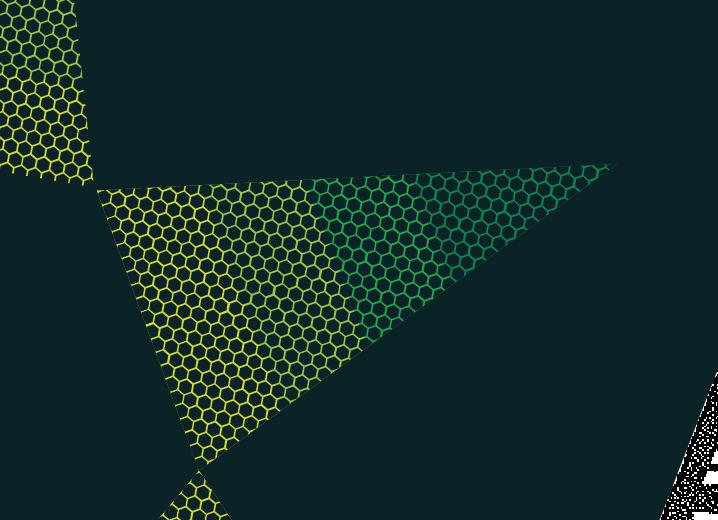

Street art by Roadsworth

Thermoplastic crosswalk in Pan-African colors, Seattle, WA
G15 Evans Street and Reade Circle intersection, with
proposed art concept: hexagonal pattern cut into radiating triangles that fade from light to dark green, positioned to form a large central hexagon; referencing the triangles and hexagons that form an emerald crystal
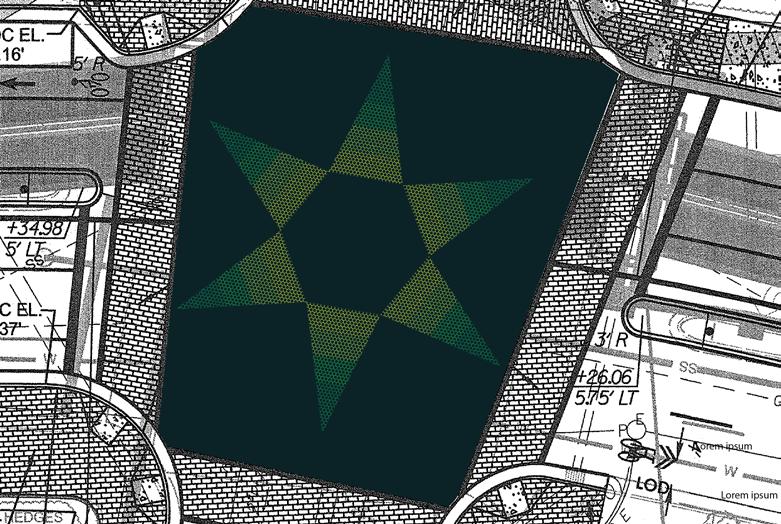

Stamped asphalt with recessed thermoplastic infill, Castro Street, San Francisco
Gateway with Archway
LOCATIONS
GO1 Pitt Street Bridge • South side, adjacent to Greenway Trail • Major vehicular entry point into Greenville's Center City along one-way Pitt Street • Entry & exit pedestrian experience along Greenway Trail
ELEMENTS • Sculptural arch extending over street Potential media and materials: • Metal • Polycarbonate • Light Fixtures • Photovoltaics
THEMES • City Gates • Emerald City • Green Edge • River Phenomena
SITE INTEGRATION • Integrate art implementation, including foundations and electrical connections, with other enhancement projects planned for the Greenway Trail, Tar River and bridge • Explore attaching sculpture to bridge structure • Combine arch with fence replacement at bridge abutment • Artist-led project
The Pitt Street Bridge crossing over the Tar River is the most definitive gateway entry into Greenville's Center City. Currently, there is no engaging visual image to greet people after they cross the river. This location lends itself to an archway over the street to mark the transition and convey civic pride. A collateral benefit to placing a sculptural archway in this location is that it would be experienced by pedestrians and cyclists moving east-west on the adjacent Greenway trail as well as by people in vehicles moving north.
G01 Pitt St. Bridge, arch location looking south to the
Center City

G01 Pitt St. Bridge, arch location looking north with
Greenway crosswalk adjacent to arch


Cycle of Arches by Jonathan Kurtz, Cleveland, OH
Gateways with Illuminated Structures
LOCATIONS
GO2 Sycamore Hill Gateway Plaza (in construction) • Iconic stained glass towers in a plaza GO3 Tar River Pedestrian Bridge (future) • Pedestrian connection between Town Common & North Greenville open space • Vehicular views from Pitt Street Bridge • Incorporate artist on design team
GO4 WWI Memorial Bridge (lighting in development) • Pedestrian experiences on Greenway Trail GO7 Gazebo on Culvert Connector (priority project) • Entry and exit feature for vehicles moving eastwest on E 3rd Street; and pedestrians moving north-south on Culvert Connector • Architectural design to include iconic illuminated tower • Artist consult with design team for lighting
G17 10th Street Underpass (priority project) • Key pedestrian and vehicular link between Dickinson & Albemarle, West Greenville • Lighting may be incorporated with ceiling, for visibility from both directions • Lighting may be washed on walls for visibility from one direction only (two-sided artwork) • Artist-led project
G18 10th Street Pedestrian Bridge (future) • Vehicular gateway for drivers on E 10th St. • Pedestrian connection between Millennium Connector and Warehouse District • Move existing sculpture closer to overpass • Incorporate artist on design team
G19 ECU Life Sciences Building (in construction) • Vehicular gateway; illuminate SW corner
G04 WWI Memorial Bridge - proposed lighting


G07 Gazebo on Culvert Connection - iconic lit tower
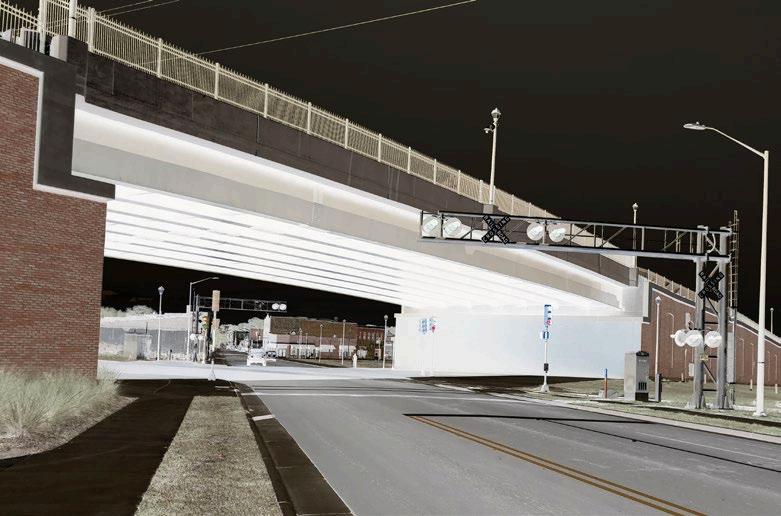
ELEMENTS • LED Light Fixtures • Photovoltaics
• Tie lighting colors to “Emerald Loop” scheme
THEMES • City of Light • Iconic Structures and Forms
G17 10th Street Underpass - ceiling and wall lighting
See Lighting Section for more information and examples
Gateway with Illuminated Tree
LOCATIONS
GO9 W. 5th Street Traffic Island (in planning) • Primary Gateway from West Greenville • Primarily vehicular experience • Traffic calming potential • Connect W. 5th Street with Elizabeth Street and Albemarle Avenue • 360-degree views

ELEMENTS • Landmark heritage tree • Annuals and other colorful understory plants with seasonal change • LED lighting • Potential for winter holiday tree lighting, if conifer
G09 W. 5th Street Existing Traffic Island - entry view
THEMES • Ecological statement: the "green" in Greenville • Theatrical landscape
SITE INTEGRATION • Incorporate with BUILD grant 5th Street improvement project • Coordinate tree placement with utilities (in particular overhead wires) • Landscape architectural tree selection • Artist consult with design team for lighting

G09 W. 5th Street Existing Traffic Island - exit view



Gateways with Rotating Sculpture
LOCATIONS
G06 W. 3rd Street and S. Pitt Street - Green Space
(owned by Pitt County)
• Vehicular gateway from West Greenville • Views traveling east or west on 3rd Street • Views walking north on Pitt Street G13 E. 5th Street at Culvert Connector • Connect ECU, Culvert Connector, Urban Core • Pedestrian and vehicular experiences G15 Evans Street and Reade Circle Library Garden • Garden environment allows for sculpture offering close-up experiences • Consider incorporating seating in this space G16 Reade Circle and Cotanche Street - Traffic
Island (existing)
• Gateway from ECU to Urban Core

G06 Rotating sculpture location at 3rd Street and S. Pitt
Street would act as a gateway element
ELEMENTS • Permanent concrete foundations • Permanent LED lighting • Temporary medium-scale rotating sculptures Potential media and materials: • Metal • Polycarbonate • Lights • Concrete • Stone • Wood • Glass
THEMES • City Greeter • Pedestrian and vehicular experiences • Human Scale • Streetscape Furniture • Outdoor Sculpture Walk
SITE INTEGRATION • Coordinate sculpture footing placement with existing utility boxes and plants • Incorporate LED lighting • Add sites to Downeast Sculpture Exhibit
G15 Rotating sculpture location at Sheppard Memorial
Library garden would act as a gateway element

G16 Existing rotating sculpture location at Reade Circle and
Cotanche Traffic Island acts as a gateway

See Sculpture Section for additional information and examples

EMERALD LOOP LIGHTING
Many existing building facades, towers and bridge structures are suitable for architectural illumination. Future buildings can also be designed to incorporate illuminated features.
A similar lighting program can be repeated on buildings throughout Greenville's Center City, cultivating a sense of place and civic identity.
Lights that change color over time can respond to special events and holidays.
Unified Civic Lighting Approach
The art of architectural illumination provides potent aesthetic effects by embracing the night as a canvas for new perspectives of familiar places. Light art can be affordable and achieved relatively quickly, while yielding a dramatic large-scale impact that transforms existing building facades, towers, columns, cupolas and other architectural features. A unified approach for lighting significant structures throughout Greenville's Center City will have a large impact, turning the entire area into an immersive art installation. To emphasize the “green” in Greenville and create a strong identity for the Emerald Arts District, a base color scheme that changes monthly could move through a range of greens over the course of a year (blue-greens in the winter and yellow-greens in the summer), with special color schemes for holidays and civic events punctuating the schedule.
It is recommended to engage a lighting designer to create a set of Aesthetic Lighting Standards. This can be used to codify a light program and a range of color-changing fixtures and control systems that individual building owners could select from, to simplify maintenance and programming protocols and make a unified civic statement.
Lighting Equipment
Long lasting, powerful, color-changing LED fixtures are available in a variety of configurations, lumen output and lenses. DMX and ethernet controllers have the ability to create a myriad of effects with many types of triggers, providing a rich palette for placemaking. Color changes through fades, dissolves and sweeps across a surface can occur over any increment of time. Controllers can be pre-programmed to easily allow for automatic color changes, including special programs to highlight special days. With technological advances in triggering systems such as motion sensors and phone app controls, light art can also be interactive. Another possibility is the projection of images onto buildings using gobos, a lens with a colored or silhouetted image, pattern or words that can be customized and changed at anytime.
Annual Lighting Calendar
Martin Luther King Jr. Day
JANUARY
Black History Month Valentine’s Day President’s Day St. Patrick’s Day Cesar Chavez Day Pirate Fest Easter Earth Day ECU Graduation Memorial Day Summer Solstice Fourth of July

Freeboot Friday Labor Day
Mexican Independence Day Freeboot Friday Breast Cancer Awareness Month Freeboot Friday Halloween Freeboot Friday Veteran’s Day Thanksgiving
Tower Illumination
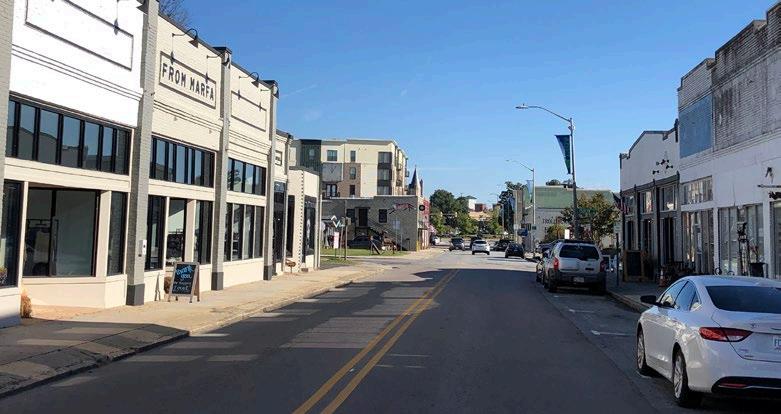
Lighting Greenville's architectural and industrial towers can create a striking "emerald city" effect. The inherent height of these structures gives them potential as beacons to provide way-finding assistance. Their unique structural qualities will take to lighting elegantly and their civic and utilitarian functions can be celebrated through light. The addition of lighting can be achieved with exterior wall washes and grazes, internal lighting and sculptural additions with integrated LED fixtures. A variety of approaches ensures distinct character for each installation, with varied costs and considerations.


View of Century Link radio tower from E. 5th St; creates gateway and is also highly visible from many other places; Night Song, Laura Garanzuay and Connie Arismendi

Empire State Building, lit from within Baltimore City Hall, exterior LED wash from below

Illuminated smoke stack and water tower in Durham, NC
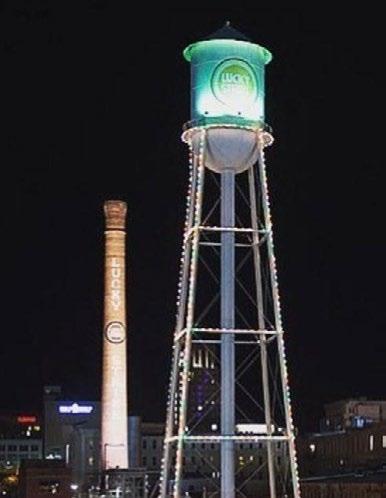

Hopwood Clock Tower, Palmerston, New Zealand
Framed axial view, from Dickinson Avenue of the City Parking Deck Clock Tower and site of future building at Evans St. Courtyard; an illuminated sculptural tower added here has unmatched potential as an iconic beacon visible from many Center City locations and drawing people from Dickinson and other places to the Urban Core; fantastic possibilities for this piece to function also as a rooftop art experience
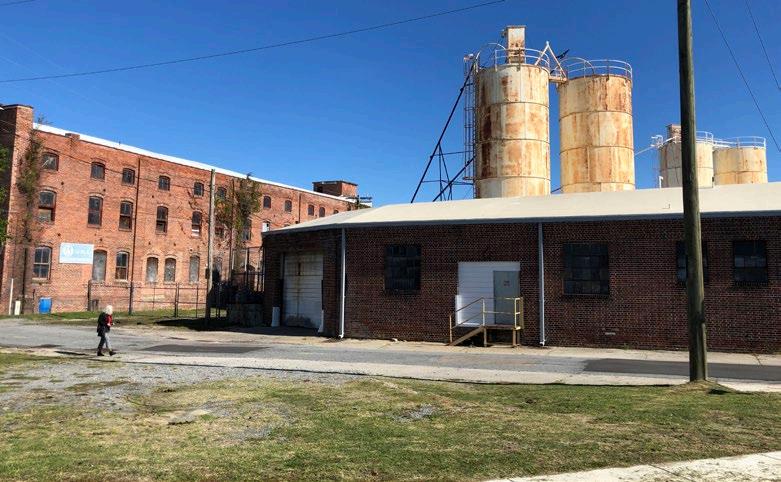
4 historic UNX tanks can be painted white or with mural and illuminated with wash fixtures mounted to roof; brick facades in various locations should also be illuminated

Lighthouse, Marblehead, MA; lit from within


Monarch, Cliff Garten; illuminated sculptural tower
Pitt County Courthouse, clock tower and columns can be lit


Cupola Building tower can be lit from within to create a lighthouse effect Herne Bay Clock Tower, Kent, England

Illuminated arches at Seattle's Pacific Science Center
Facade Illumination
Facade illumination capitalizes on preexisting architectural details by providing novel ways of viewing them. Intentionally angled lights cast shadows to accentuate form and, with color, dramatically change the nighttime appearance of a building, transforming the architecture’s character into a more theatrical version. A variety of fixture configurations and lens angles allows for custom effects matched to architecture. Lighting can also be used on the inside of the building to activate window spaces, creating a sense of mystery and life within the otherwise vacant structure.

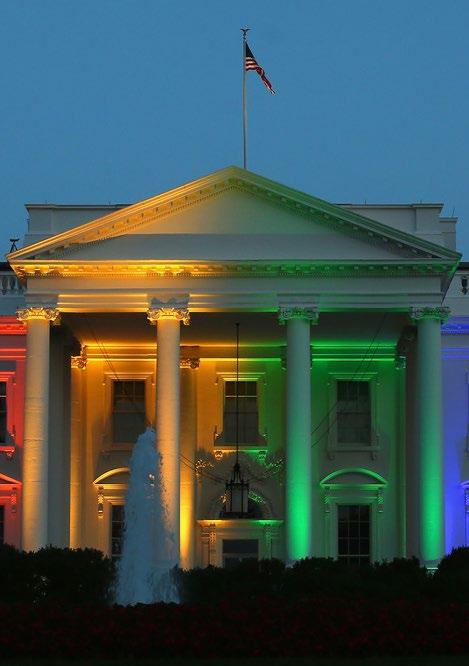

Fire Station garage door arcade could be accented with linear graze of colored light across top; possibly programmed to change color during an emergency event
State Theater, with iconic brick details

Sheppard Memorial Library and various other Center City Greenville buildings offer vertical columns that can be lit

Illuminated columns and facade

City Hall existing illumination could be enhanced with brighter color-changing fixtures
Interior and exterior LED lighting accentuates brick details of historic horse stables in Genk, Belgium


Combination of interior and exterior LED lighting creates magical effect Illuminated underpass by Herman Kuijer, in Zupthen, Netherlands 10th Street Connector Underpass; ceiling and walls can be painted with a light color or mural and illuminated with wash fixtures; from the point of view of the automobile, angle of walls makes each side visible from one direction only, creating potential for two-sided, entry/exit installation


